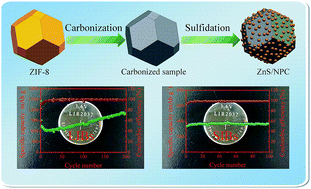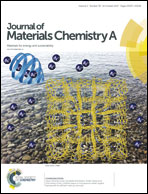ZnS nanoparticles decorated on nitrogen-doped porous carbon polyhedra: a promising anode material for lithium-ion and sodium-ion batteries†
Abstract
Rational fabrication and structure design of anode materials with high specific capacity and excellent cycling stability are of significant importance for the development of high-performance lithium-ion batteries (LIBs) and sodium-ion batteries (SIBs). In this paper, a zeolitic imidazolate framework-8 (ZIF-8) with a unique polyhedral morphology and large size (about 2 μm) was successfully synthesized through a facile co-precipitation method. After successive carbonization and sulfidation, ZnS nanoparticles decorated on nitrogen-doped porous carbon polyhedra (ZnS/NPC) were obtained. When applied as the anode material for LIBs, the ZnS/NPC hybrid displays the highest reversible specific capacity for ZnS-based electrodes reported so far (1067.4 mA h g−1 at 0.1 A g−1 after 200 cycles), excellent rate capability (364.6 mA h g−1 at 4 A g−1), and robust long-term cycling performance (856.8 mA h g−1 at 1 A g−1 after 1000 cycles). As for SIBs, the resultant ZnS/NPC also exhibits a desirable capacity of 370.6 mA h g−1 after 100 cycles at 0.1 A g−1 and 289.2 mA h g−1 after 1000 cycles at 1 A g−1. Such superior lithium and sodium storage performances should be attributed to the distinctive structure advantages inherited from ZIF-8, where the Zn ions were in situ converted to ZnS with high reactivity upon electrochemical cycling and the organic linkers were pyrolyzed to nitrogen-doped porous carbon polyhedra to enhance the conductivity of the hybrid and keep the structure stability during cycling.



 Please wait while we load your content...
Please wait while we load your content...